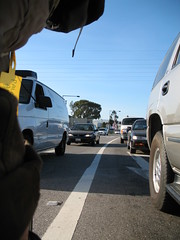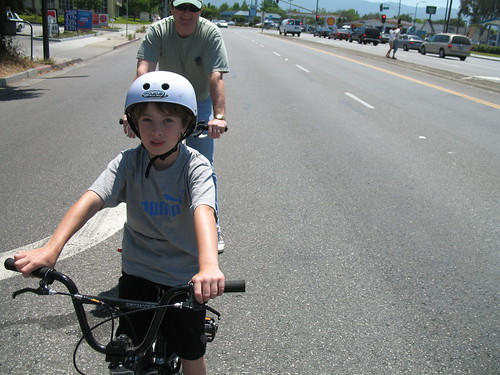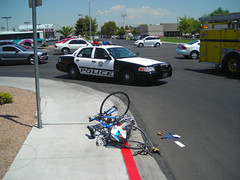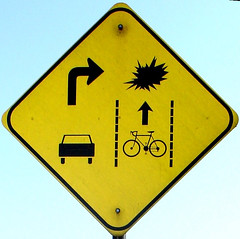The Seattle Times published this decent article on the danger of “right hooks” from motorists. This is the hazard of a motorist who passes the cyclist then turns right directly in front of the cyclist, which often results in the cyclist hitting the side of the car. It’s probably the most common type of accident for cyclists and is sometimes fatal to the cyclist, especially when it’s a truck that hooks the cyclist.
The Times article notes that bike lanes can increase the hazard to cyclists by creating a false sense of security for the cyclist.
I can’t agree with the suggestion in the article that urban cyclists stay alive by assuming we’re “invisible to all drivers” and to “ride paranoid.” If I want to be invisible, I’ll ride in the bike lane — I ride to be visible by positioning myself in the traffic when necessary and by signaling my intentions. My last collision (and my first in over a decade) occurred when I was hooked last fall while I was invisible in the bike lane. I ride defensively, but I believe that’s different from riding as if I’m invisible or paranoid. For the most part, motorists are not out to get me, if only to avoid the inconvenience of a police report and insurance claim on their part. (Incidentally, for the snarky straw man idiots in the A&S forum over at BikeForums.net, positioning myself to be seen and for destination does not mean blocking whole lines of traffic behind me also).

Cyclists in California are taught to leave the bike lane or the right turn lane and position themselves for their direction of travel. The California Driver Handbook says this regarding bike lanes:
When you are making a right turn and are within 200 feet of the corner or other driveway entrance, you must enter the bike lane for the turn. Do not drive in the bike lane at any other time.
I should note that motorists are required to merge into the bike lane only if the lane is clear, the same as if they’re merging right into a regular traffic lane. If everybody actually followed this rule, we’d cut down substantially on the number of right hooks.
Before anybody complains that “this is too hard”, let me direct you to the photo below showing a ten year old boy to the left of a right turn lane on busy Saratoga Avenue at I-280 in San Jose, California. The photo doesn’t show it (I wouldn’t have snapped the photo when the traffic was heavy), but moments after the photo was snapped traffic caught up from the intersection behind us and passed us on the right and the left. The right turn lane in the photo is access to an Interstate Highway on ramp. The Santa Clara County bike map labels this intersection “extreme caution” because of the heavy and fast traffic.

Here’s
another example of a cyclist positioning herself for her destination by moving to the left of the right turn lane.
Of course, the California “solution” is not a panacea — there are still idiot drivers and even (dare I write it?) idiot cyclists. Here’s a dramatic video from the San Francisco Bicycle Coalition showing a cyclist getting hooked at speed by a driver making an illegal right turn from Market onto Octavia up in San Francisco.
The solution? I believe increased education for both motorists and cyclists on the hazard of right hook can help. Awareness through general media outlets like the Seattle Times article is good. Oh, and it’s a “left cross,” not a left hook. See Bicycle Safe for other types of common bike collisions and how to avoid them.
Please be sure to hit the Digg, del.icio.us and CycleCluster buttons below if you think this article is worth sharing. Thanks!



